
What a beautiful Mango! I thought Mango season was already ended on Kauai this year but this was a first crop at Rebecca and Mo's garden. I felt honored and grateful to receive this Mango as a gift. Also I was very happy to know their experiment to use "Kajitsu-burkuro" for Mango was successful.

Kajitsu-bukuro(果実袋) is a Japanese word, which literally means a "fruit bag." It is an individual paper & plastic bag to protect fruit or vegetable from bugs, pests, and sunshine. Since most farmers in Japan use this bag, fruits sold in Japan are very beautiful! In addition, they are very delicious.
I knew and saw fruit bags in Japan but I didn't realize the importance of the bags until uncle Mo told me he was looking for this. So when I went to Japan in March, I bought and brought some bags to Kauai.

This is the picture Rebecca sent me some time ago. This bag has a plastic window so that you can see if it's ready to pick.


Again, beautiful and tasty Mango! I guess I should get some more bags when I have another chance to go to Japan!
By the way, there are so many types of Mangos are now listed in the Wikipedia;
|
Common name(s) |
Image |
Origin/ region |
Notes | ||
|---|---|---|---|---|---|
| Alampur Baneshan |

|
India, United States | |||
| Alice |

|
United States | |||
| Almaas | Pakistan | ||||
| Alphonso |
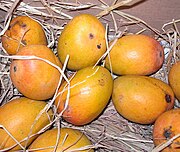
|
India, Pakistan, Ecuador, Egypt, Sudan, United States, Nepal | "King of Mangoes", very sweet with fibreless pulp, rich in vitamin A and C, founded mainly in Devgad & Ratnagiri Districts of Maharashtra, India. This cultivar is available in Feb till end of May. | ||
| Amrapali | India | ||||
| Anderson |
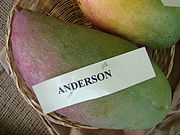
|
United States | |||
| Angie |

|
United States | |||
| Anwar Ratol | India, UP, Multan, Punjab (Pakistan) | Small in size and flesh without fibre . Peak season is mid July to August. | |||
| Ataulfo |

|
Ecuador, Mexico | |||
| Bailey's Marvel |

|
United States | |||
| Banganapalli |

|
India | The largest volume mango cultivar in the world, this medium-large fruit ripens to a golden-yellow exterior and a straw-yellow to golden-yellow interior. Very juicy, slightly tangy with little or no fibre and a creamy texture. It originates from the erstwhile princely state of Banganapalle, in present-day Andhra Pradesh, India. | ||
| Bennet Alphonso |
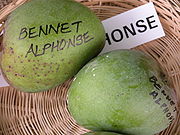
|
United States | |||
| Beverly |
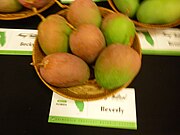
|
United States | |||
| Black and Rose]] | India Kerala | Black and Rose [4] | |||
| Bombay |

|
India, Nepal, United States | |||
| Brahm Kai Meu |
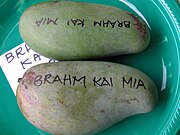
|
United States | |||
| Brooks |

|
Australia, United States | |||
| Carabao (Philippine Mango) |
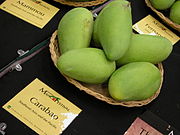
|
Philippines | The Ataulfo (mango) and Manilita mango cultivars originated from the Philippine Mango variety. It can be traced back in the Manila-Mexico galleon trade in the years 1600-1800's.[5] | ||
| Carrie |

|
United States | |||
| Chaunsa |

|
India, Sindh, Pakistan | |||
| Chok anan | Pakistan, Bangladesh, India, Thailand | ||||
| Cogshall |
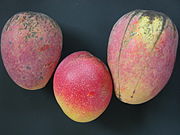
|
United States | |||
| Cushman |

|
United States | |||
| Dasheri | India, Nepal, Pakistan, | It originated in Village Dasehri, Block Kakori, Lucknow (UP) India. The Mother Tree of Dasehri Mango is still alive and bearing fruits. It is estimated to be 200–300 years old. There are various stories about its origin but the owners say it is a "chance" seedling. | |||
| Dot |

|
United States | |||
| Dudhiya Malda | India, Nepal | Grown in Digha, Patna, Bihar. Known for awesome taste and flavour with thin skin[6][7][8][9] | |||
| Duncan |
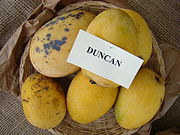
|
United States | |||
| Earlygold |
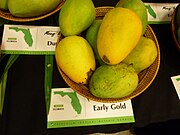
|
United States | |||
| Edward |

|
United States | |||
| Eldon |

|
United States | |||
| Emerald | United States | ||||
| Fazli (mango) | Bangladesh, India | ||||
| Fajri Kalan | Pakistan | ||||
| Fairchild | United States | ||||
| Fascell |

|
United States | |||
| Florigon |

|
United States | |||
| Ford |
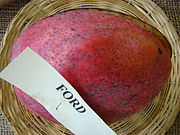
|
United States | |||
| Gary |

|
United States | |||
| Gir Kesar | Gujarat (India) | ||||
| Glenn |

|
Italy, United States | |||
| Gold Nugget |
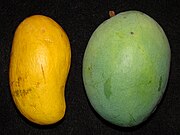
|
United States | |||
| Golden Lippens | United States | ||||
| Graham |

|
United States | |||
| Haden |

|
Australia, Brazil, Costa Rica, Ecuador, Guatemala, Honduras, Mexico, United States | |||
| Hatcher | United States | ||||
| Heidi | South Africa | ||||
| Himayat / Imam Pasand |
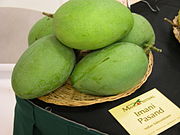
|
India | |||
| Himsagar |

|
Bangladesh, India, Nepal | |||
| Ice Cream | United States | ||||
| Irwin |
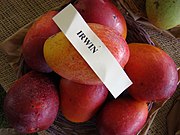
|
Australia, Costa Rica, United States, Taiwan, Japan (Okinawa) | In Japan this variety is marketed as Apple Mango, and in the case of imports from Japan one needs to take care not to confuse it with the Apple Mango grown in the Philippines. | ||
| Ivory |

|
China | Also known as the Jingu Ivory mango, or Ivory mango, this long, thin mango is named for its resemblance to a young elephant's tusk. It has thin skin, smooth skin. The flesh contains very few fibres, and constitutes approximately 82 percent of the fruit. It was first introduced into Yunnan, China from Thailand in 1914. The actual tree that was the first to be imported still grows, and during one year produced almost 500 kg of fruit.[10] | ||
| Jakarta |
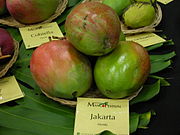
|
United States | |||
| Jean Ellen |

|
United States | |||
| Julie | Ecuador, United States | A colourful, potato shaped mango with a sweet-tart flavour and a tall growth habit. Very popular in the Caribbean Sea, including Jamaica the British Virgin Islands, the United States Virgin Islands, and Barbados. | |||
| Kalepad | Andhra Pradesh, India | ||||
| Keitt |

|
Australia, Costa Rica, Ecuador, Italy, South Africa, United States | |||
| Kensington Pride |

|
Australia, Italy, United States | |||
| Kent |
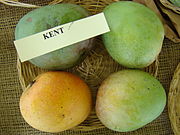
|
Australia, Ecuador, Guatemala, Honduras, Israel, Italy, Mexico, South Africa, United States | |||
| Lakshmanbhog | India | ||||
| Lancetilla |
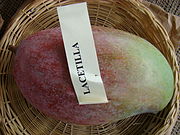
|
Honduras, United States | |||
| Langra |
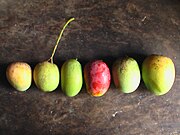
|
India, Pakistan, Bangladesh, | |||
| Lippens |

|
United States | |||
| Madame Francis | Haiti | Large kidney shaped mango that ripens to a golden yellow colour with piquant flesh Commonly exported to the United States in spring; often a feature of NYC fruit stands. | |||
| Mallika |

|
India, Nepal, United States | |||
| Manilita | United States | ||||
| Momi K[11] | Hawaii, United States | Teardrop shaped with a narrow point. Ripens to a reddish orange blush. Flesh has creamy consistency. | |||
| Muhammad Wala | Pakistan | ||||
| Mulgoba |

|
India, United States | |||
| Neelam | India, Pakistan | ||||
| Osteen |
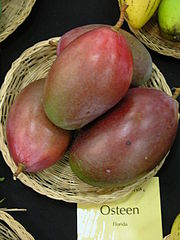
|
Italy, Spain, United States | |||
| Palmer |
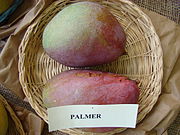
|
Australia, Brazil, United States | |||
| Parvin |

|
United States | |||
| Raspuri |

|
Karnataka, India | An extremely popular variety in South India, a fully ripe Raspuri mango harvested at the right time and ripened naturally can beat them all, including the Alphonso, in taste as well as amount of juice per mango. Many people especially Kannadigas do not even ask for any another variety except Raspuri in Bengaluru. | ||
| Rosigold |
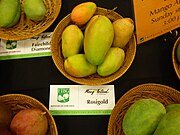
|
United States | |||
| Ruby |
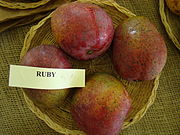
|
United States | |||
| Saigon |

|
United States | |||
| Sindhri |

|
Sindh Pakistan | Sindhi Mango cultivated in Sindhri town Mirpur Khas district, Sindh province of Pakistan | ||
| Saharni | Pakistan | ||||
| Sammar Bahisht | Pakistan, India | ||||
| Sensation |

|
South Africa, United States | |||
| Shan-e-Khuda |

|
Pakistan | |||
| Sindhri |

|
Mirpur Khas district, Sindh province of Pakistan | Sindhi Mango cultivated in Sindhri town Mirpur Khas district, Sindh province of Pakistan | ||
| Sophie Fry |

|
United States | |||
| Southern Blush | United States | ||||
| Spirit of '76 | United States | ||||
| Springfels |

|
United States | |||
| Sunset |
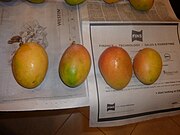
|
United States | |||
| Tommy Atkins |

|
Brazil, Costa Rica, Ecuador, Guatemala, Honduras, Israel, Italy, Mexico, South Africa, United States, Venezuela | One of the most commonly sold mangoes in the world. has extremely long shelf life. Hard and oblong exterior. | ||
| Torbert | United States | ||||
| Totapuri |
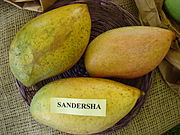
|
India | |||
| Valencia Pride |

|
South Africa, United States | |||
| Van Dyke |

|
Italy, United States | |||
| Young | United States | ||||
| Zill |

|
South Africa, United States |
 Koloa Jodo Mission - Buddhist Temple Since 1910
Koloa Jodo Mission - Buddhist Temple Since 1910












Write a comment